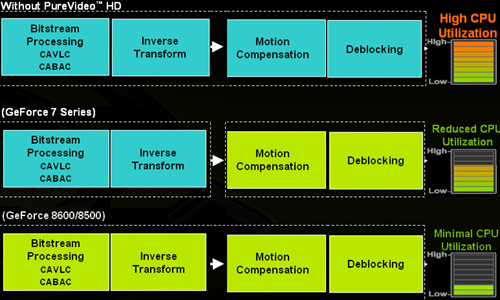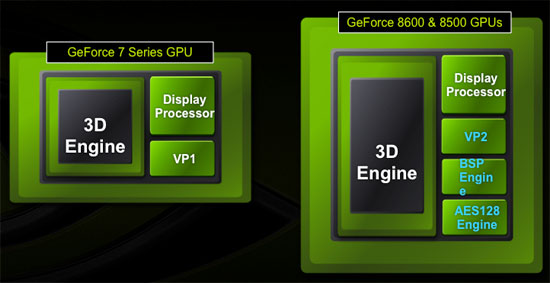NVIDIA GeForce 8600: Full H.264 Decode Acceleration
by Anand Lal Shimpi on April 27, 2007 4:34 PM EST- Posted in
- GPUs
NVIDIA has always been the underdog when it comes to video processing features on its GPUs. For years ATI had dominated the market, being the first of the two to really take video decode quality and performance into account on its GPUs. Although now defunct, ATI maintained a significant lead over NVIDIA when it came to bringing TV to your PC. ATI's All-in-Wonder series offered a much better time shifting/DVR experience than anything NVIDIA managed to muster up, usually too late on top of that. Obviously these days most third party DVR applications have been made obsolete by the advent of Microsoft's Media Center 10-ft UI, but when the competition was tough, ATI was truly on top.
While NVIDIA eventually focused on more than just 3D performance with its GPUs, NVIDIA always seemed to be one step behind ATI when it came to video processing and decoding features. More recently, ATI was first to offer H.264 decode acceleration on its GPUs at the end of 2005.
NVIDIA has remained mostly quiet throughout much of ATI's dominance of the video market, but for the first time in recent history, NVIDIA actually beat ATI to the punch on implementing a new video related feature. With the launch of its GeForce 8600 and 8500 GPUs, NVIDIA became the first to offer 100% GPU based decoding of H.264 content. While we can assume that ATI will offer the same in its next-generation graphics architecture, the fact of the matter is that NVIDIA was first and you can actually buy these cards today with full H.264 decode acceleration.
We've taken two looks at 3D gaming performance of NVIDIA's GeForce 8600 series and came away relatively unimpressed, but for those interested in watching HD-DVD/Blu-ray content on their PCs does NVIDIA's latest mid-range offering have any redeeming qualities?
Before we get to the performance tests, it's important to have an understanding of what the 8600/8500 are capable of doing and what they aren't. You may remember this slide from our original 8600 article:

The blocks in green illustrate what stages in the H.264 decode pipeline are now handled completely by the GPU, and you'll note that this overly simplified decode pipeline indicates that the GeForce 8600 and 8500 do everything. Adding CAVLC/CABAC decode acceleration was the last major step in offloading H.264 processing from the host CPU, and it simply wasn't done in the past because of die constraints and transistor budgets. As you'll soon see, without CAVLC/CABAC decode acceleration, high bitrate H.264 streams can still eat up close to 100% of a Core 2 Duo E6320; with the offload, things get far more reasonable.

The GeForce 8600 and 8500 have a new video processor (that NVIDIA is simply calling VP2) that runs at a higher clock rate than its predecessor. Couple that with a new bitstream processor (BSP) to handle CAVLC/CABAC decoding, and these two GPUs can now handle the entire H.264 decode pipe. There's a third unit that wasn't present in previous GPUs that has made an appearance in the 8600/8500 and that is this AES128 engine. The AES128 engine is simply used to decrypt the content sent from the CPU as per the AACS specification, which helps further reduce CPU overhead.
Note that the offload NVIDIA has built into the G84/G86 GPUs is hardwired for H.264 decoding only; you get none of the benefit for MPEG-2 or VC1 encoded content. Admittedly H.264 is the more strenuous of the three, but given that VC1 content is still quite prevalent among HD-DVD titles it would be nice to have. Also note that as long as your decoder supports NVIDIA's VP2/BSP, any H.264 content will be accelerated. For MPEG-2 and VC1 content, the 8600 and 8500 can only handle inverse transform, motion compensation and in-loop deblocking and the rest of the pipe is handled by the host CPU; VP1 NVIDIA hardware only handles motion compensation and in-loop deblocking. ATI's current GPUs can handle inverse transform, motion compensation and in-loop deblocking, so they should in theory have lower CPU usage than the older NVIDIA GPUs on this type of content.
It's also worth noting that the new VP2, BSP and AES128 engines are only present in NVIDIA's G84/G86 GPUs, which are currently only used on the GeForce 8600 and 8500 cards. GeForce 8800 owners are out of luck, but NVIDIA never promised this functionality to 8800 owners so there are no broken promises. The next time NVIDIA re-spins its high end silicon we'd expect to see similar functionality there, but we're guessing that it won't be for quite some time.










64 Comments
View All Comments
PrinceGaz - Friday, April 27, 2007 - link
Copying a movie from an optical disc (DVD/HD-DVD/Blu-Ray) to your HDD is perfectly legal as it does not involve interfering with the protection on those files, all you are doing is creating an image-file on your hard-disk which contains all the necessary data on the optical-disc. The image-file can then be mounted with suitable software and played as normal in your preferred media player, with the media-player software handling the decrypting just as it would with an original disc.It's ripping the movie that contravenes the DMCA as that is the step which involves removing the encryption from the data. Ripping can be done either direct from the original optical disc or from an image-file on your hard-drive, the only difference is that creating an image-file first is an extra step to be performed but on the other hand it simplifies what is involved with each stage and means the only task being performed while reading the original disc is a straight copy to the hard-drive. Having an image on the hard-drive also saves a lot of time if more than one attempt might be needed to perform a successful rip.
On topic, once quad-core CPUs are mainstream in a year or two (with octal-core arriving at the high-end), H.264 decoding on the GPU will be irrelevant really-- nice to have but of no real importance, rather like how the Pentium III and original Athlon rendered hardware MPEG2 decoder cards obsolete.
Ard - Saturday, April 28, 2007 - link
Well (and don't get me wrong, I hate the DMCA, believe me), your argument would arguably fail under the strict language of the statute. The DMCA defines circumvention as "descrambl[ing] a scrambled work, decrypt[ing] an encrypted work, or otherwise to avoid, bypass, remove, deactivate, or impair a technological measure, without the authority of the copyright owner". A direct copy would probably be viewed as avoiding CSS/AACS/etc. since they exist for the sole purpose of preventing you from making a copy. I personally think your argument is more than valid because you still need a media player to decrypt the image file, but you know content providers would argue the exact opposite.smilingcrow - Friday, April 27, 2007 - link
"On topic, once quad-core CPUs are mainstream in a year or two (with octal-core arriving at the high-end), H.264 decoding on the GPU will be irrelevant really-- nice to have but of no real importance, rather like how the Pentium III and original Athlon rendered hardware MPEG2 decoder cards obsolete."I thought it was the implementation of hardware assist of MPEG2 decoding on GPUs that was the boon for DVD playback on PCs back in the day with ATI being the pioneers!
It’s still useful to have this feature regardless of quad cores from the perspective of lower power consumption, lower CPU heat output which is easier to cool quietly and better multi-tasking abilities. It’s a niche feature but for people who use it it’s something for nothing especially with the 8500 GT supporting it. Gigabyte have a passive 8500 GT that supports HDCP for $100; my next card I think.
yyrkoon - Friday, April 27, 2007 - link
SO, what you're saying is that: You can watch a HD-DVD from HDD, you just can't put it there ? lol, reminds me of one of the laws Canada supposedly had for a while, something similar to: you can download all the pirated software/media you want, you just couldnt store it on any form of media . . .Anyhow, I wonder how long AMD/ATI is going to stay silent, it seems a good bit of time since we've heard anything from them, at least, in the form of a review. Not that I miss all the fanboyistic comments . . .
BoberFett - Friday, April 27, 2007 - link
The power consumptions graphs show Peak lower than Average...Anand Lal Shimpi - Friday, April 27, 2007 - link
Fixed :)Cascavel - Friday, April 27, 2007 - link
I ask out of ignorance, but why did you not try the NERO software for HD playback - I think it is an add-on to NERO 7 / Showtime 3 ?Anand Lal Shimpi - Friday, April 27, 2007 - link
Great question, but I believe that only PowerDVD/WinDVD support the 8600's hardware acceleration at this point. I will double check :)Take care,
Anand
Hulk - Saturday, April 28, 2007 - link
The Showtime 3 release notes says "nVidia decode" a few generations ago. Perhaps they have updated it or maybe it will work. If you could test with Showtime 3 that would be great.Cobra Commander - Friday, April 27, 2007 - link
I wasn't expecting it to be this dramatic. Nice. Bummer the GTX doesn't have this tech though. :(